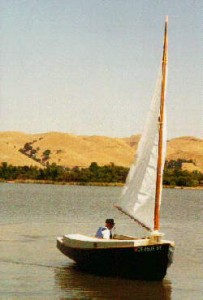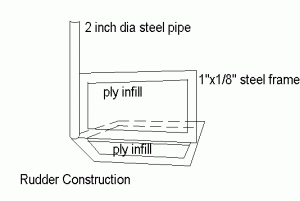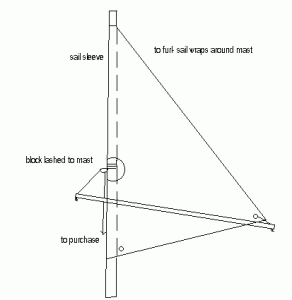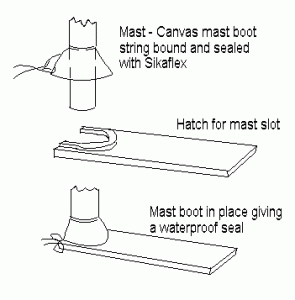Chebacco News
Number 12, November 1996
[All issues of Chebacco News can be seen (in glorious colour) on the World Wide Web at: http://www.tay.ac.uk/mcsweb/staff/wbs/chebacco.html]

Bill Samson’s ‘Sylvester’ impersonates the Chebacco News logo
The first ‘Glass-house’ Chebacco?
Bob Cushing (b.cushing@csss-a.cv.com) emailed to tell me that he is building the high- sided Chebacco motorsailer, dubbed the ‘glass-house version’ by Phil Bolger (Boats with an Open Mind – pages 225-227). As far as I can tell, this will be the first to be built to this design. Bob writes:
I have started building the highsided Chebacco motorsailer – have the bottom, ballast keel and rudder built and some of the bulkheads. I will be turning it rightside up shortly and starting to install the bulkheads, stem and sides.
Bob also mentions that he has built the Microtrawler (currently for sale!) and the Fast Motorsailer (both described in BWAOM). He hasn’t added the sailing rig to the Fast Motorsailer, yet, but is so pleased with its performance under power, he may not add it.
Lapstrake Chebaccos
Gil Fitzhugh reports steady progress on his lapstrake Chebacco. He is currently fitting out the hull:
The forward bulkhead is in, the aft one is cut out and the hidden one at the backend of the centerboard trunk is spiled. The aft bulkhead has a pretty top that I wanted to cover with a curved strip of laminated mahogany – two tight bends one way and two the other. It worked, but what a job! Bulding boats is duck soup. Building yachts, on the other hand . . .
I just hope, that with all that loving care and attention Gil is lavishing on his Chebacco, he can screw up the courage to dump it in the water when the time comes!
Gil also tells me that he is seriously thinking about putting on a bowsprit and jib, following the glowing report from Fraser Howell in the last issue. He has put a substantial breasthook into the hull so that a short bowsprit can be bolted through the deck and breasthook.
Another lapstrake Chebacco builder, Jerome McIlvanie, of Yakima, Washington reports that he built his hull right side up, turned it over using the pulley and ropes method (see Chebacco News #1) for painting. He then plans to turn it back over to finish it off.
Yet another builder who has decided to build the lapstrake version is George Cobb, of New Brunswick, Canada. He writes:
I won’t have building space for another 2-3 months. In the meantime I have completed the lofting and am well along on the spars. I would like to hear whether anybody has used a gooseneck on the boom and its merits and drawbacks as compared to gaff jaws.
I went for a sail in Fraser Howell’s boat three weeks ago. The winds were light but it was still a very enjoyable sail. I especially enjoyed nosing up to a beach and going ashore.
George Cobb
If you use a gooseneck on the boom you’ll be in good company, George. Sister Krista’s ‘Toulooma Too’, built by Brad Story (see Chebacco News #7) has a gooseneck. It certainly looks very neat and works well. I used jaws on my boom because I like low-tech things that are easily fixed, wherever I am. The only slight advantage of jaws is that the height of the boom above the deck can be adjusted using the throat halyard – but this is no big deal.
Another sheet ply Chebacco?
I am sometimes accused to being rather biassed towards the sheet ply version of the Chebacco. OK – I fess up! (- you’d think I was an American or something -) I am biassed. So it gladdens my heart to hear that another one is about to start taking shape. Garry Foxall, of British Columbia, writes: I am going to build the sheet ply version, although Jim Slakov’s [a lapstrake version] is so pretty it makes me want to do that instead. However, I have a number of other projects that must be done, and I think that the sheet ply one will be faster.
I hope to begin cutting out bulkheads and temporary frames this month. December is when I hope to begin the actual construction.
Jim Slakov lives a few miles away. He turned his hull over in the early summer and is now working on the centerboard trunk. He is a cabinetmaker by trade and his workmanship is beautiful. It makes one feel envious.
Garry.
Chebacco a tad big for you? How about a Catfish Beachcruiser!
John Tuma, of Fremont California has launched his Catfish Beachcruiser (a recent Bolger design). He has called it ‘Catfish Lounge’, in view of the astonishingly spacious cockpit/cabin. John writes:
The hull form is similar to the sheet ply Chebacco . . .
The particulars:
LOA 15’1”
Beam 6’6”
Draft 15”
Trailer weight ~800 lbs
Displ (sailing) ~1000-1200 lbs
Sail area 139 square feet
She has a long, shallow keel and no centreboard, giving an uncluttered interior. The deck is raised to the height of the top of the coaming and there is a narrowish walkway down the centre which forms the cockpit when sailing, and can be easily covered over at night to give sleeping accommodation (rather like the Birdwatcher, but less extreme). So you get a huge cockpit and huge sleeping accommodation, too.
John emailed me to say:
The Lounge offers commodious seating, occasionally excellent dining, and often an excellent view. Performance to windward is not as slow as I first thought. I had my sailmaker join me for an afternoon on the Oakland Estuary, and we played with the various controls. Throat halyard tension was improved with the addition of a 2-to-1 purchase, and greater luff tension improved windward performance in light airs. In heavier conditions or with a lightly loaded boat the increased luff tension tends to induce weather helm. I did not expect the rig to be so sensitive to tuning, so now I feel I’m learning about sail controls all over again.
I’ve also found the lounge to be sensitive to loading. Four adults and two children can fit without trouble, but the boat doesn’t sail well with that much weight (at least not when chips and dip are more important than weight placement). Very slow to get going, and slow downwind. The increased momentum made tacking in light airs easier, the deeper profile reduced leeway. However, I’ve been having fun with the sideways motion, and a downwind dock can be taken by stalling the boat and sliding in sideways. I do have to be careful though, as the same thing would happen on a lee shore. I have also found that the Lounge likes to be sailed on the bilge panel, and flies on a reach when that far over. Is the same true of the Chebacco?
John
It certainly is! The downside is, though, that the greater the heel, the greater the weather helm. On balance, I like to sail my sheet ply Chebacco with a little heel, but not with the gun’l under! Sailing singlehanded, as I often do, this can mean taking in a reef earlier than when I have a crew to sit on the weather bench.
First, the model . . .
James (Skip) Pahl, of Carlsbad, California, writes:
I’ve just started my 3/4” to 1’ model. The hull is done and today I’m beginning the post-turn-over interior work. I am hoping the model comes out looking as sweet as the one you built. [Aw! Shucks! – B.S.] It might give courage at the office during a week that seems an unnecessarily long interruption to one’s time on the water.
I was fascinated by Fraser Howell’s recent comments about his bowsprit and jib, and wondered if his Chebacco points higher than those with cat rigs or might require reefing later since the jib tends to relieve the weather helm when the main is overpowered. Also, I’d like to learn how he installed the bowsprit. It seem to me that, with a careful job of tapering the spar, it could look great with the 19th century lines of the boat.
I’d also be grateful for your thoughts about using plastic laminate on the interior or the centerboard trunk and of using an aluminium plate for the centerboard.
Skip
Well, Fraser, some of this is for you to look into. Formica-lined centreboard trunks have been used successfully by boatbuilders for a long time now. I only wish I’d heard about it before spending days glassing the inside of my trunk! I’d be very wary of an aluminium centreboard. Made to the same thickness as shown on the plans, it’d be very heavy and would probably need a winch to raise it. A thinner one would need a narrower trunk and might get bent and jam up. You’ll recall that Fraser laminated a central core of aluminium in plywood, giving the same weight/density as the lead- weighted plywood centreboard of the plans (see Chebacco News #11).
Skip also emailed Gil Fitzhugh and myself asking how to fit the carlins and cuddy sides. Gil replied:
. . . there are floors at roughly stations 2 3/4 and 3 3/4. After they and the inwale are in place, you can tie the carlin to those floors and inwale with string, or wires and turnbuckles, like this –
By adjusting the tension on the strings you can pull the carlins into a fair curve relative to the sheer in both profile and plan view. Note that the top and inside faces of the carlin, to which the deck and cuddy sides will be fastened, are unobstructed. After you’ve fastened the deck and cuddy sides to the unobstructed faces of the carlin with screws and epoxy, the carlin ain’t goin’ noplace, never again . . .
My own approach is rather cruder. I left in the temporary molds 2 and 3, and used these to determine the shape of the carlins. Once the cuddy sides and side decks were fitted, I crawled into the cuddy with a handsaw and chopped the molds up so they could be removed. Untidy, but it works!
Professional advice available
Bill Buchholz has recently returned to the USA from Finland, where he supervised the building of a modified Chebacco at the boatbuilding school in Hamina. Bill has kindly offered to provide advice to amateur builders of Chebacco. He can be contacted at Apache Boatworks, RFD 4517, Camden, ME 04843, USA, phone 207-236-8048.
Weight aft, Mizzen Sails and Mast Boots
Peter Gray of Queensland, Australia refers to Jamie Orr’s query about weight at the back end of the Chebacco. He writes:
I was concerned about this with Grey Feather. The rudder was built of steel-
so instead of the Oregon mizzen mast weighing 12 kgs I used a second hand windsurfer mast costing $50 and weighing 2 kgs. I got the sailmaker to sew a sleeve in the mizzen sail to go over this. It works really well. I also have an 8 hp Johnson outboard weighing 27 kgs. I have found this combination of items works well (weight and function).
About the mast slot and sealing it – this was also of major concern to me as I don’t like water in the hull. I made a hatch cover for the slot and a boot for the mast.
Grey Feather went to the Brisbane (Down by the River) Festival on August 23-24. This was a celebration of the 150th year of Newstead House, house of the Governor of Queensland, Australia. The house is on the banks of the Brisbane river. Incorporated with these celebrationswas a heritage and vintage boat show. Gray Feather was part of this and was met with great enthusiasm
Peter Gray
And Finally . . .
Please keep your news coming; whether about sailing or building or even just dreaming. This is your newsletter and we can all benefit from each others’ experience. For the first time, in this issue, I have devoted some space to a Bolger boat which isn’t a Chebacco – John Tuma’s Catfish. Please let me know whether I should occasionally discuss Bolger designs which might be alternatives to Chebacco, or whether I should stick strictly to Chebaccos.
Happy building, sailing, modelling, dreaming, . . .
Bill Samson,
88 Grove Road,
West Ferry,
Dundee,
DD5 1LB,
Scotland.
w.samson@tay.ac.uk





